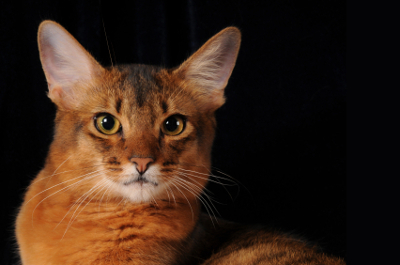Somail Cat
Category: Cats

Facts about Somail Cats "Scientific name for Somail Cat is Felis Catus". The "Somali cat" is a long haired variety of the Abyssinian. The Somali Cat were first noted in the early twentieth century. The Somali Cat came about after the World War II when cat breeders had introduced a long haired cat into their breeding programs. At this time the Abyss were considered to be few and far. It is only after 1970s that the Somali Cat breeds had were developed and were given the name, Somali which was a nod to the countries geographical status being next to Abyssinia presently, Ethiopia the Somali Cats are considered to weigh approximately six to ten pounds.
The Somali Cats have their ticked coat being similar to that of the Abyssinian. However, the Somali Cats have an additional length with their coats having an alternating dark and light color bands on each of their hair shafts. Their ticking can develop much slower than that of the Abyssinian. The Somali Cat have broad ears, wedge-shaped head with huge, almond-shaped, green or gold eyes which have dark lines extending to their brows. The Somali Cats muscular bodies are supported by fine-boned slim legs with compact oval paws and a tail which is usually thick with a slight tapering at its end.
The Somali cats have their coats ticked with black or a darker brown color. The Somali Cat nose leather are usually tiled-red with their paws being brown in color. Others may have different color coats ranging from chocolate brown coats with cinnamon ticked, pink nose leathers and blue paw pads to various shades of slate blue coats with beige ticked, old rose nose leathers and mauve paw pads or rose-beige ticked with light brown, salmon nose leather and paw pads which are pink in color.
A female cat is called a "queen or molly", male cat is called a "tom" and the name "clowder" is called a group of young cats, baby cats are called kittens.
Somali Cats have an average weight around 8.7 to 11 pounds (3.9 to 5 kg). Somali Cats have very sharp hearing and their sense of smell is fantastic.
The Somali Cats usually live life to their fullest. The Somali Cat are highly inquisitive and intelligent. The Somali Cat are always seen to jump further, play harder and climb higher. Their lives are always considered to be continuously challenging and full of entertainment.
The Somali Cats are considered to have multiple health problems including the periodontal diseases, hyperesthia which cause them to gloom themselves leading to hair loss, patellar luxation and the progressive retinal a trophy..
Somali Cats on average sleep 13 to 14 hours a day and when they are awake, the spend a lot of time licking themselves to keep themselves clean. Somali Cats help control rodents like small rats and mice where they live such as farm homes, warehouse their houses ect.
The Somali cats require moderate grooming at least twice a week to prevent tangle, distribute skin oil and to remove dead hair.
The scientific name for cat "Felis Catus". The fear of cats "Ailurophobia".
Somail Cat Facts
Somali Cats average life span is around 12 to 15 years. The reason why Somali Cats can squeeze through very small spaces is that they have no collarbone and free-floating clavicle bones that their shoulders are attach to their forelimbs, that's why a Somali Cat can fit through a hole the same size as its head and they use their whiskers to determine if they can fit through the space.
Somali Cats can see at levels of light six time lower than a human, this is why Somali Cats can catch mice so easily at night. Somali Cats outer ear uses 32 muscles to control it, and a human has only 6 muscles in its ear and a cat can move its ears 180 degrees. A Somali Cat can move their ears independently.
The cat's hairball is called a "bezoar" (meaning a concretion or calculus found in the intestines or stomach of certain animals, in particular ruminants, formerly alleged to be an effective cure for poison). A Somali Cat can climb up a tree well but can not climb head first down a tree, because all the claws on a cat’s paw points the same direction, to get down from a tree, a Somali Cat has to back down. A Somali Cat can run at a top speed of about 30 mph (48.2 km) over a short distance.
The average temperature of a Somali Cat is 101.5 °F. The Somali Cats heart beats at 110 to 140 a minute, that is almost twice as fast as a human heart. A Somali Cats has 30 teeth while a kittens has about 26 teeth that they will lose at about 6 months of age. A Somali Cat has the ability to jump up to six times its length
A Somali Cat rubs against a person to not only to be affectionate but also to mark out its territory. A Somali Cat does not like water because its fur is not insulate it well when it gets wet. A Somali Cat averages about 12 whiskers on both side of its face. A Somali Cats jaw can not move sideways, there for a cat can not chew large pieces of food. A Somali Cats back is highly flexible because of its 53 loosely fitting vertebrae. The body of a Somali Cat has 230 bones. While a human body has 206. Compared to a humans who only have 34. The fear of cats "Ailurophobia".

 Back To Category Cats
Back To Category Cats